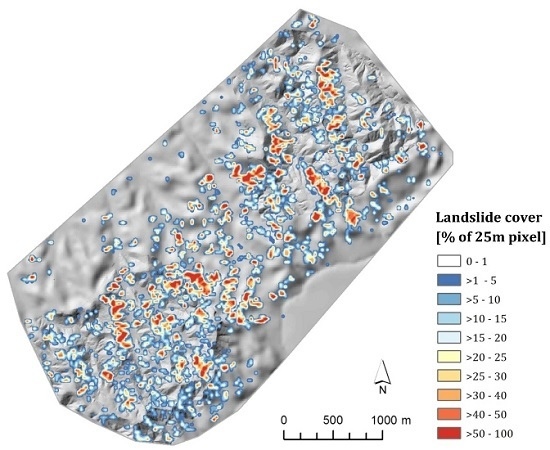Identifying Spatio-Temporal Landslide Hotspots on North Island, New Zealand, by Analyzing Historical and Recent Aerial Photography
Abstract
:1. Introduction
2. Materials and Methods
2.1. Study Area
2.2. Data
2.3. Visual Landslide Interpretation
2.4. Semi-Automated Landslide Mapping
2.5. Identification of Landslide Hotspots
3. Results
3.1. Landslide Mapping Results
Comparison of Semi-Automated Mapping with Visual Interpretation
3.2. Landslide Hotspots
4. Discussion
5. Conclusions
Acknowledgments
Author Contributions
Conflicts of Interest
Abbreviations
| DEM | Digital Elevation Model |
| HR | High Resolution |
| LINZ | Land Information New Zealand |
| OBIA | Object-based Image Analysis |
| PSI | Persistent Scatterer Interferometry |
| RGB | Red, Green, Blue |
| SAR | Synthetic Aperture Radar |
| VHR | Very High Resolution |
References
- De Rose, R.C.; Trustrum, N.A.; Blaschke, P.M. Post-deforestation soil loss from steepland hillslopes in Taranaki, New Zealand. Earth Surf. Proc. Land 1996, 18, 131–144. [Google Scholar] [CrossRef]
- Dymond, J.R.; Ausseil, A.-G.; Shepherd, J.D.; Buettner, L. Validation of a region-wide model of landslide susceptibility in the Manawatu-Wanganui region of New Zealand. Geomorphology 2006, 74, 70–79. [Google Scholar] [CrossRef]
- Basher, L.R.; Betts, H.D.; De Rose, R.C.; Lynn, I.H.; Marden, M.; McNeill, S.J.; Sutherland, A.; Willoughby, J.; Page, M.J.; Rosser, B. Accounting for the Effects of Mass-movement Erosion on Soil Carbon Stocks in the Soil Carbon Monitoring System: A Pilot Project, Landcare. Research Contract Report LC 288; Landcare Research: Lincoln, New Zealand, 2011; p. 89. [Google Scholar]
- De Rose, R.C. Slope control on the frequency distribution of shallow landslides and associated soil properties, North Island, New Zealand. Earth Surf. Proc. Land 2013, 38, 356–371. [Google Scholar] [CrossRef]
- Galli, M.; Ardizzone, F.; Cardinali, M.; Guzzetti, F.; Reichenbach, P. Comparing landslide inventory maps. Geomorphology 2008, 94, 268–289. [Google Scholar] [CrossRef]
- Hölbling, D.; Friedl, B.; Eisank, C. An object-based approach for semi-automated landslide change detection and attribution of changes to landslide classes in northern Taiwan. Earth Sci. Inform. 2015, 8, 327–335. [Google Scholar] [CrossRef]
- Guzzetti, F.; Mondini, A.C.; Cardinali, M.; Fiorucci, F.; Santangelo, M.; Chang, K.-T. Landslide inventory maps: New tools for an old problem. Earth-Sci. Rev. 2012, 112, 42–66. [Google Scholar] [CrossRef]
- Guzzetti, F.; Cardinali, M.; Reichenbach, P.; Carrara, A. Comparing Landslide Maps: A Case Study in the Upper Tiber River Basin, Central Italy. Environ. Manag. 2000, 25, 247–263. [Google Scholar] [CrossRef]
- Mondini, A.C.; Viero, A.; Cavalli, M.; Marchi, L.; Herrera, G.; Guzzetti, F. Comparison of event landslide inventories: The Pogliaschina catchment test case, Italy. Nat. Hazards Earth Syst. Sci. 2014, 14, 1749–1759. [Google Scholar] [CrossRef]
- Van Westen, C.J.; Asch, T.W.J.; Soeters, R. Landslide hazard and risk zonation—Why is it still so difficult? Bull. Eng. Geol. Environ. 2005, 65, 167–184. [Google Scholar] [CrossRef]
- Mantovani, F.; Soeters, R.; van Westen, C.J. Remote sensing techniques for landslide studies and hazard zonation in Europe. Geomorphology 1996, 15, 213–225. [Google Scholar] [CrossRef]
- Van Westen, C.J.; Castellanos, E.; Kuriakose, S.L. Spatial data for landslide susceptibility, hazard, and vulnerability assessment: An overview. Eng. Geol. 2008, 102, 112–131. [Google Scholar] [CrossRef]
- Dikau, R.; Brunsden, D.; Schrott, L.; Ibsen, M.L. Landslide Recognition: Identification, Movement and Causes; Wiley & Sons: Chichester, UK, 1996; p. 274. [Google Scholar]
- Singhroy, V. Remote sensing of landslides. In Landslide Hazard and Risk; Glade, T., Anderson, M.G., Crozier, M.J., Eds.; Wiley & Sons: West Sussex, UK, 2005; pp. 469–492. [Google Scholar]
- Michoud, C.; Abellan, A.; Derron, M.H.; Jaboyedoff, M. SafeLand Deliverable 4.1. Review of Techniques for Landslide Detection, Fast Characterization, Rapid Mapping and Long-Term Monitoring. 2010, p. 401. Available online: https://www.google.at/url?sa=t&rct=j&q=&esrc=s&source=web&cd=3&cad=rja&uact=8&ved=0ahUKEwi9lcr1p_3PAhUMDcAKHXdnCLEQFggkMAI&url=https%3A%2F%2Fwww.geologie.ac.at%2Fuploads%2Ftx_lumophpinclude%2FfileOutput.php%3Fid%3D726&usg=AFQjCNH8h3smmwM-1wRwAYM1HfTRkqDedA&bvm=bv.136811127,d.bGg (accessed on 31 October 2016).
- Coblentz, D.; Pabian, F.; Prasad, L. Quantitative Geomorphometrics for Terrain Characterization. Int. J. Geosci. 2014, 5, 247–266. [Google Scholar] [CrossRef]
- Moosavi, V.; Talebi, A.; Shirmohammadi, B. Producing a landslide inventory map using pixel-based and object-oriented approaches optimized by Taguchi method. Geomorphology 2014, 204, 646–656. [Google Scholar] [CrossRef]
- Heleno, S.; Matias, M.; Pina, P.; Sousa, A.J. Semiautomated object-based classification of rain-induced landslides with VHR multispectral images on Madeira Island. Nat. Hazards Earth Syst. Sci. 2016, 16, 1035–1048. [Google Scholar] [CrossRef]
- Hölbling, D.; Füreder, P.; Antolini, F.; Cigna, F.; Casagli, N.; Lang, S. A Semi-Automated Object-Based Approach for Landslide Detection Validated by Persistent Scatterer Interferometry Measures and Landslide Inventories. Remote Sens. 2012, 4, 1310–1336. [Google Scholar] [CrossRef] [Green Version]
- Kurtz, C.; Stumpf, A.; Malet, J.-P.; Gançarski, P.; Puissant, A.; Passat, N. Hierarchical extraction of landslides from multiresolution remotely sensed optical images. ISPRS J. Photogramm. 2014, 87, 122–136. [Google Scholar] [CrossRef]
- Lahousse, T.; Chang, K.-T.; Lin, Y. Landslide mapping with multiscale object-based image analysis—A case study in the Baichi watershed, Taiwan. Nat. Hazards Earth Syst. Sci. 2011, 11, 2715–2726. [Google Scholar] [CrossRef] [Green Version]
- Lu, P.; Stumpf, A.; Kerle, N.; Casagli, N. Object-oriented change detection for landslide rapid mapping. IEEE Geosci. Remote Sens. 2011, 8, 701–705. [Google Scholar] [CrossRef]
- Martha, T.R.; Kerle, N.; van Westen, C.J.; Jetten, V.; Vinod Kumar, K. Object-oriented analysis of multi-temporal panchromatic images for creation of historical landslide inventories. ISPRS J. Photogramm. 2012, 67, 105–119. [Google Scholar] [CrossRef]
- Stumpf, A.; Kerle, N. Object-oriented mapping of landslides using Random Forests. Remote Sens. Environ. 2011, 115, 2564–2577. [Google Scholar] [CrossRef]
- Blaschke, T.; Hay, G.J.; Kelly, M.; Lang, S.; Hofmann, P.; Addink, E.; Queiroz Feitosa, R.; van der Meer, F.; van der Werff, H.; van Coillie, F.; et al. Geographic Object-Based Image Analysis—Towards a new paradigm. ISPRS J. Photogramm. 2014, 87, 180–191. [Google Scholar] [CrossRef] [PubMed]
- Chen, G.; Hay, G.J.; Carvalho, L.; Wulder, M.A. Object-based change detection. Int. J. Remote Sens. 2012, 33, 4434–4457. [Google Scholar] [CrossRef]
- Blaschke, T. Object based image analysis for remote sensing. ISPRS J. Photogramm. 2010, 65, 2–16. [Google Scholar] [CrossRef]
- Drăguţ, L.; Blaschke, T. Automated classification of landform elements using object-based image analysis. Geomorphology 2006, 81, 330–344. [Google Scholar] [CrossRef]
- Strahler, A.H.; Woodcock, C.E.; Smith, J.A. On the nature of models in remote sensing. Remote Sens. Environ. 1986, 20, 121–139. [Google Scholar] [CrossRef]
- Hölbling, D.; Betts, H.; Spiekermann, R.; Phillips, C. Semi-automated landslide mapping from historical and recent aerial photography. In Proceedings of the 19th Agile 2016 Conference on Geographic Information Science, Helsinki, Finland, 14–17 June 2016; p. 5.
- Moine, M.; Puissant, A.; Malet, J.-P. Detection of landslides from aerial and satellite images with a semi-automatic method. Application to the Barcelonnette basin (Alpes-de-Hautes-Provence, France). In Proceedings of the Landslide Processes: From Geomorphological Mapping to Dynamic Modelling, Strasbourg, France, 6–7 February 2009; pp. 63–68.
- Rau, J.-Y.; Jhan, J.-P.; Rau, R.-J. Semiautomatic object-oriented landslide recognition scheme from multisensor optical imagery and DEM. IEEE Trans. Geosci. Remote Sens. 2014, 52, 1336–1349. [Google Scholar] [CrossRef]
- Blaschke, T.; Feizizadeh, B.; Hölbling, D. Object-Based Image Analysis and Digital Terrain Analysis for Locating Landslides in the Urmia Lake Basin, Iran. IEEE J. Sel. Top. Appl. 2014, 7, 4806–4817. [Google Scholar] [CrossRef]
- Earthquakes without Frontiers. Nepal: UPDATED (28 May) Landslide Inventory Following 25 April Nepal Earthquake. Available online: http://ewf.nerc.ac.uk/2015/05/28/nepal-updated-28-may-landslide-inventory-following-25-april-nepal-earthquake (accessed on 5 October 2016).
- Bianchini, S.; Cigna, F.; Righini, G.; Proietti, C.; Casagli, N. Landslide hotspot mapping by means of Persistent Scatterer Interferometry. Environ. Earth Sci. 2012, 67, 1155–1172. [Google Scholar] [CrossRef]
- Lu, P.; Casagli, N.; Catani, F.; Tofani, V. Persistent Scatterers Interferometry Hotspot and Cluster Analysis (PSI-HCA) for detection of extremely slow-moving landslides. Int. J. Remote Sens. 2012, 33, 466–489. [Google Scholar] [CrossRef]
- Lu, P.; Bai, S.; Casagli, N. Investigating Spatial Patterns of Persistent Scatterer Interferometry Point Targets and Landslide Occurrences in the Arno River Basin. Remote Sens. 2014, 6, 6817–6843. [Google Scholar] [CrossRef]
- Land Information New Zealand (LINZ). NZ Contours (Topo, 1:50k). Available online: https://data.linz.govt.nz/layer/768-nz-contours-topo-150k (accessed on 5 October 2016).
- Baatz, M.; Schäpe, A. Multiresolution Segmentation—An optimization approach for high quality multi-scale image segmentation. In Angewandte Geographische Informationsverarbeitung XII; Strobl, J., Blaschke, T., Griesebner, G., Eds.; Wichmann: Heidelberg, Germany, 2000; pp. 12–23. [Google Scholar]
- Behling, R.; Roessner, S.; Kaufmann, H.; Kleinschmit, B. Automated Spatiotemporal Landslide Mapping over Large Areas Using RapidEye Time Series Data. Remote Sens. 2014, 6, 8026–8055. [Google Scholar] [CrossRef]
- Highland, L.M.; Bobrowsky, P. The Landslide Handbook—A Guide to Understanding Landslides; U.S. Geological Survey: Reston, VA, USA, 2008; p. 129.
- Congalton, R.G. A review of assessing the accuracy of classification of remotely sensed data. Remote Sens. Environ. 1991, 37, 35–46. [Google Scholar] [CrossRef]
- Betts, H.D.; Basher, L.R.; Dymond, J.D.; Herzig, A.; Marden, M.; Phillips, C.J. Landslide-slope relationships in New Zealand hill country—Application to a sediment budget model. Environ. Model. Softw. 2016. under review. [Google Scholar]
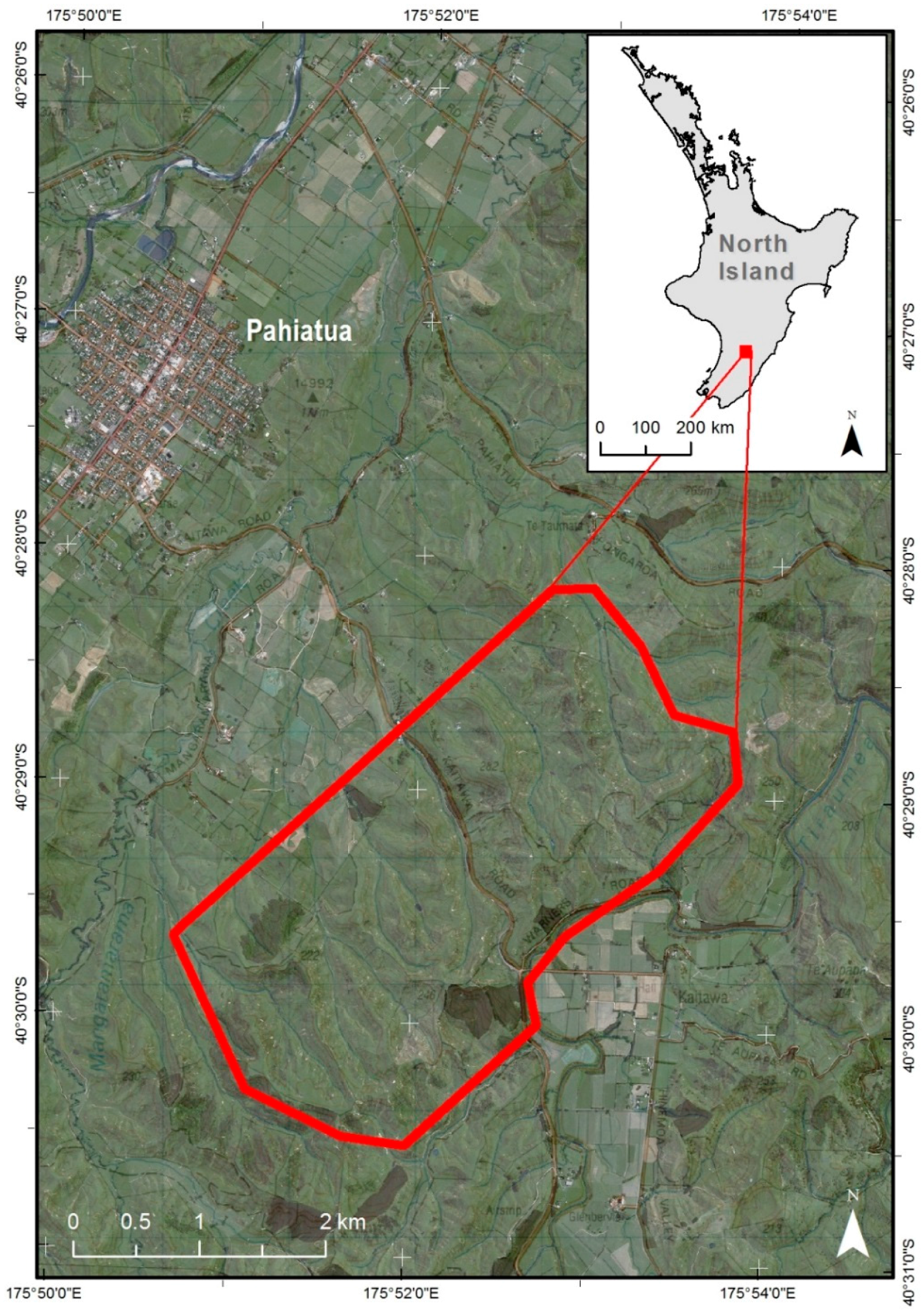
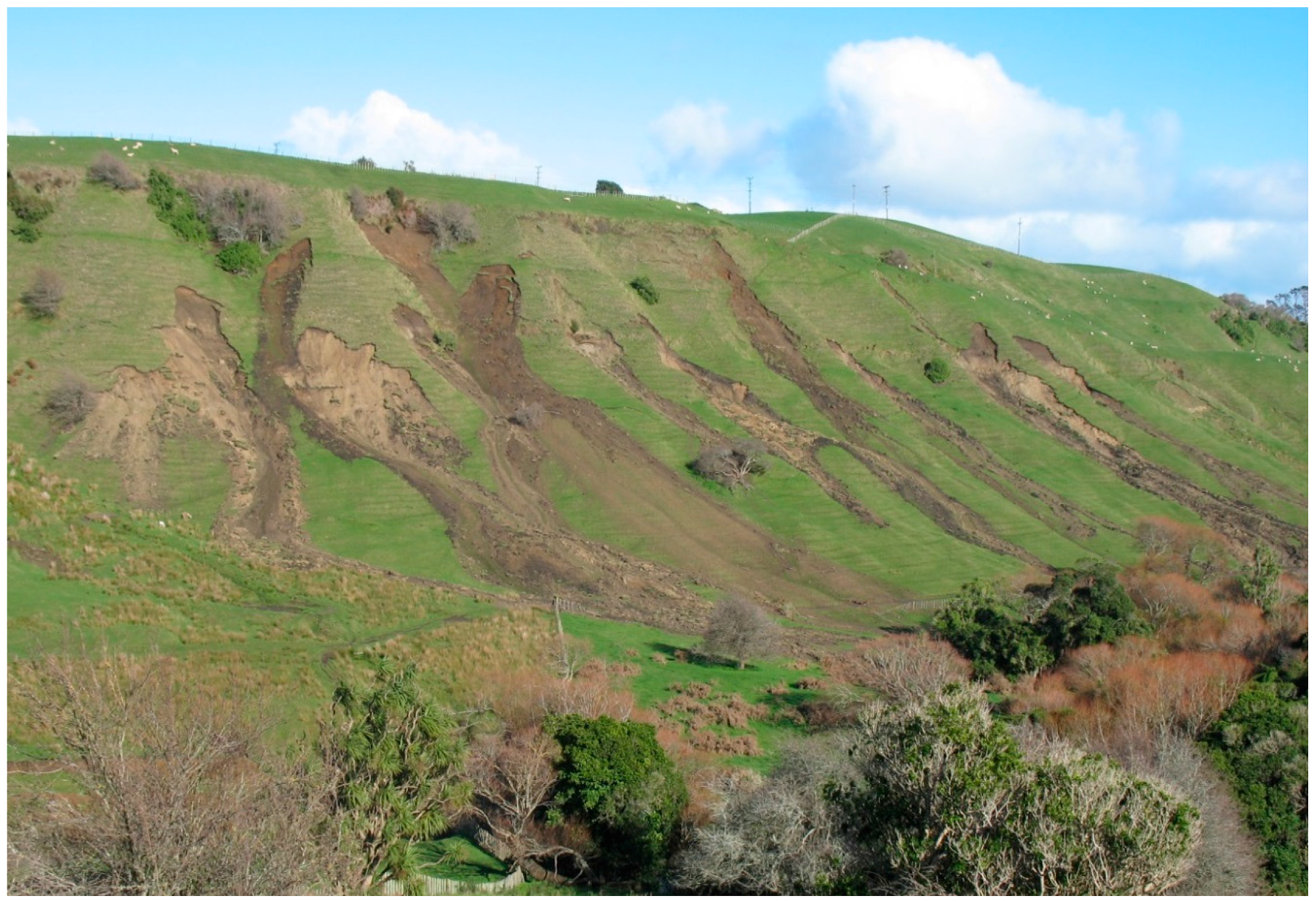
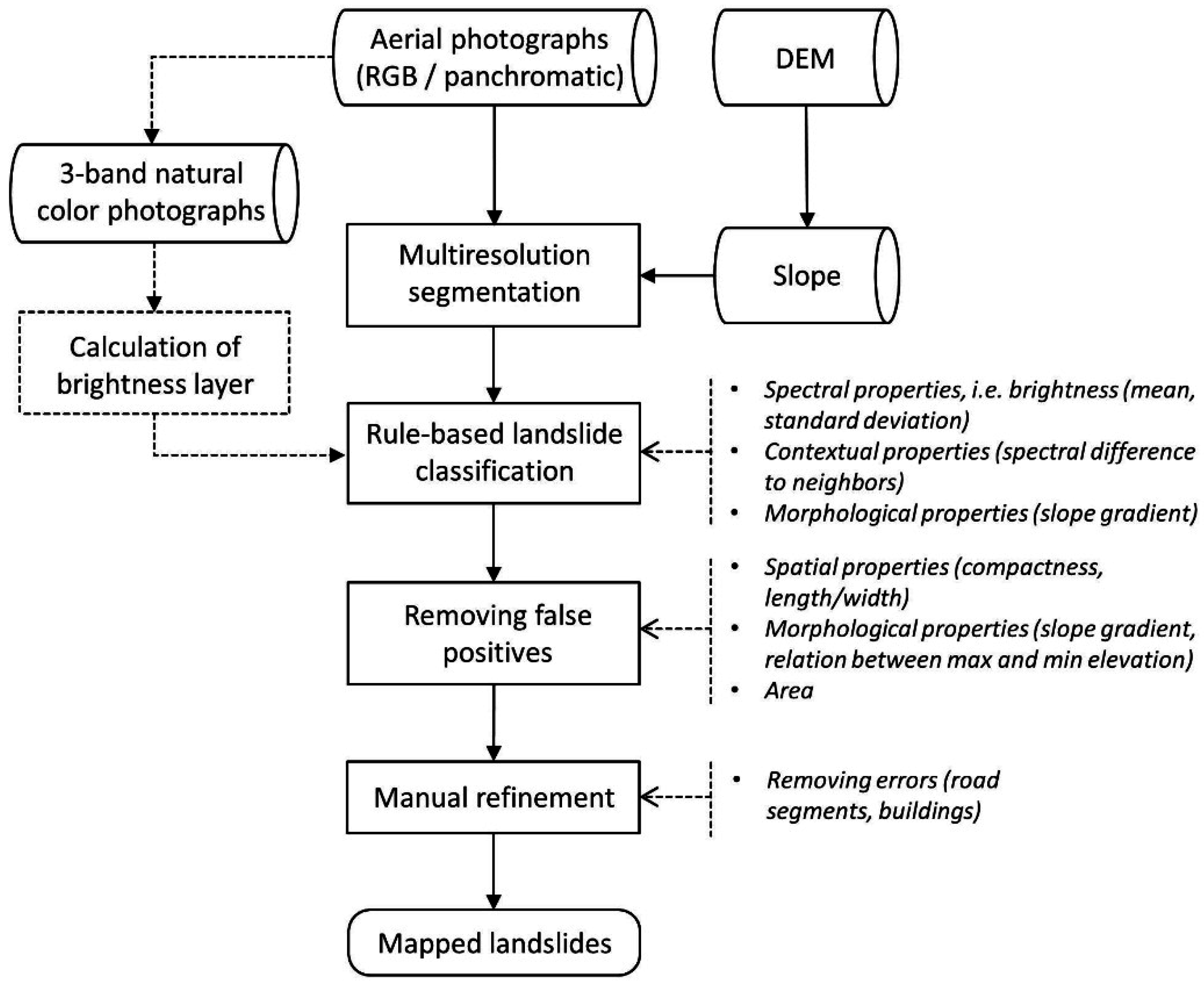


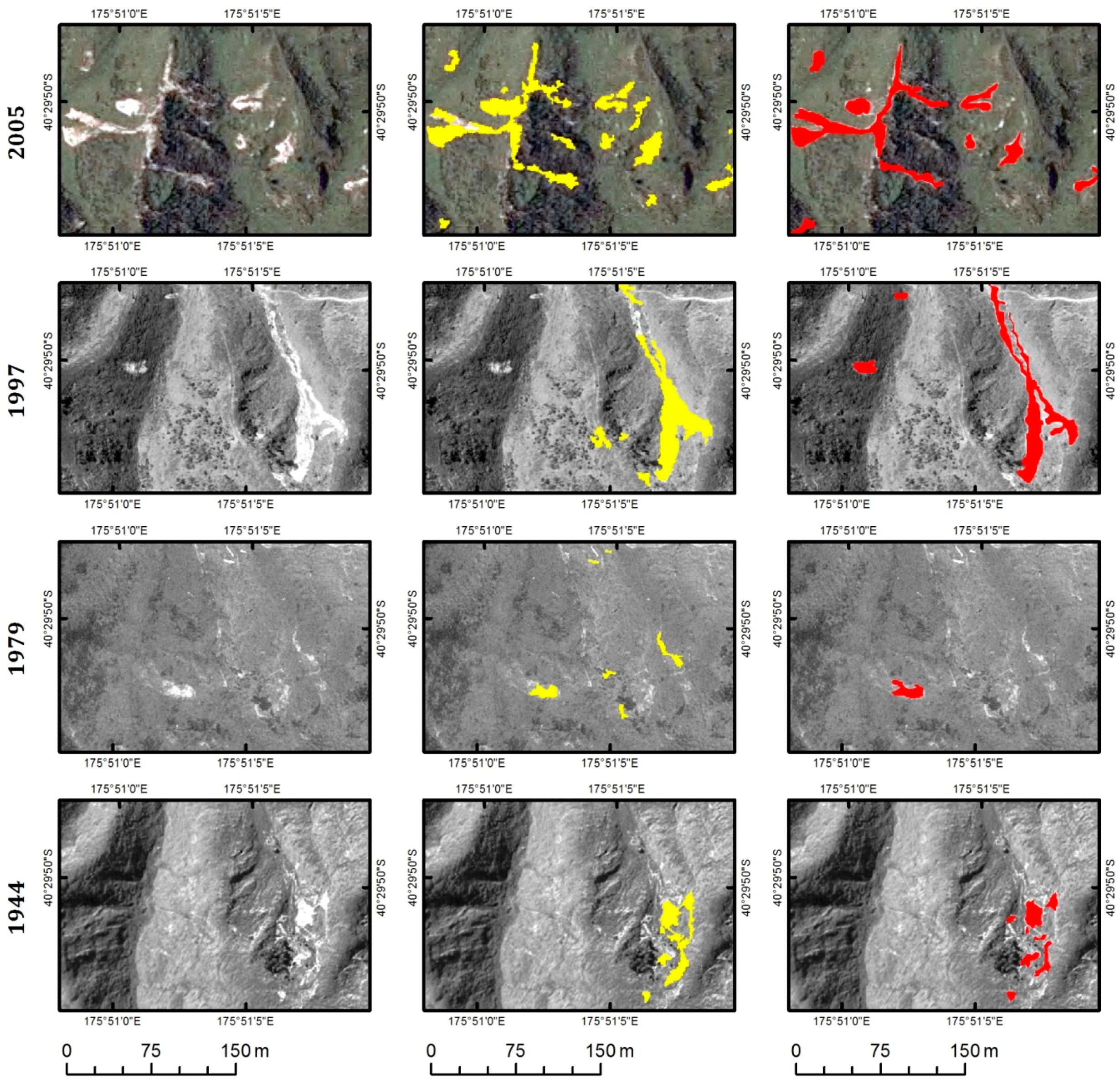
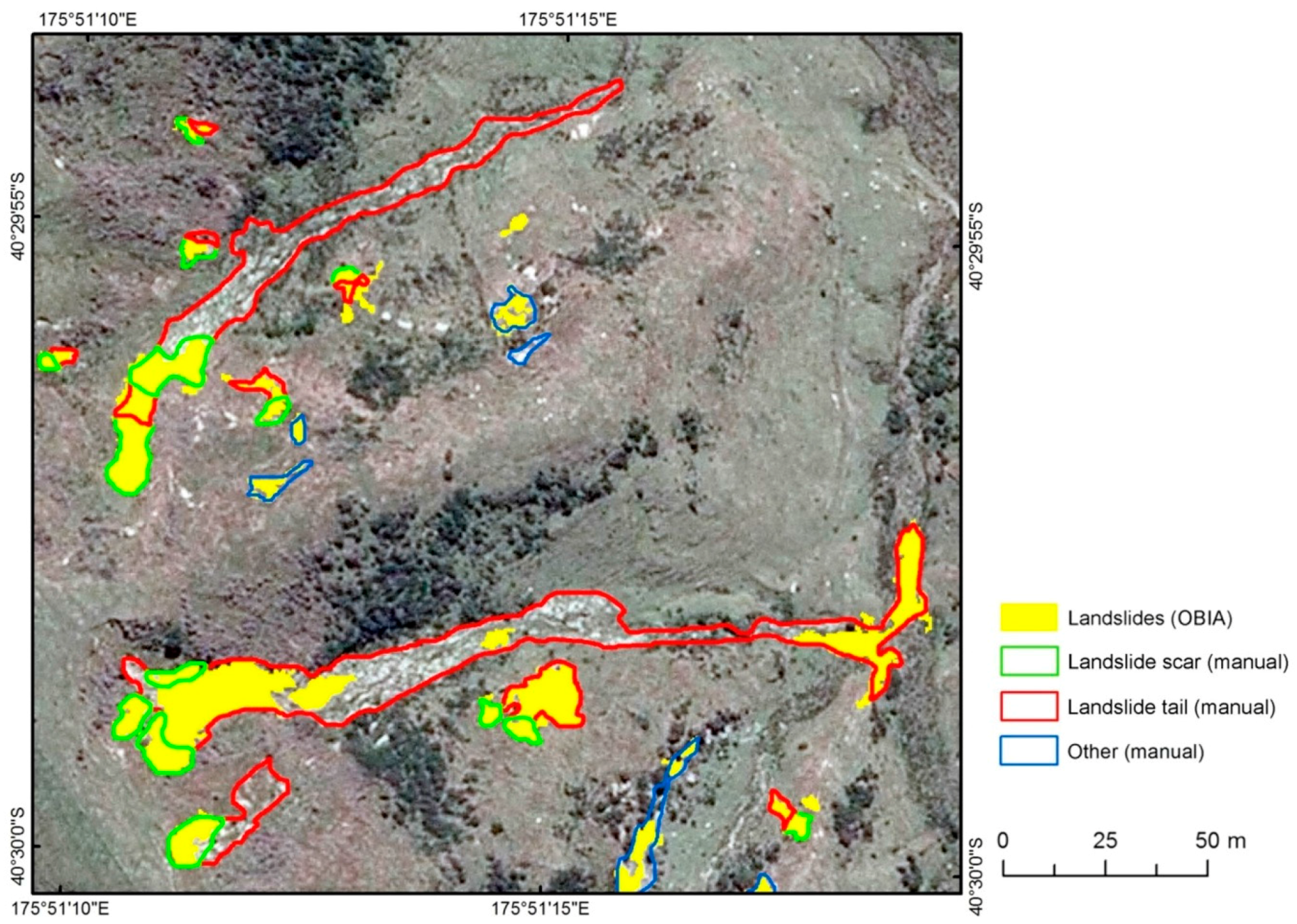
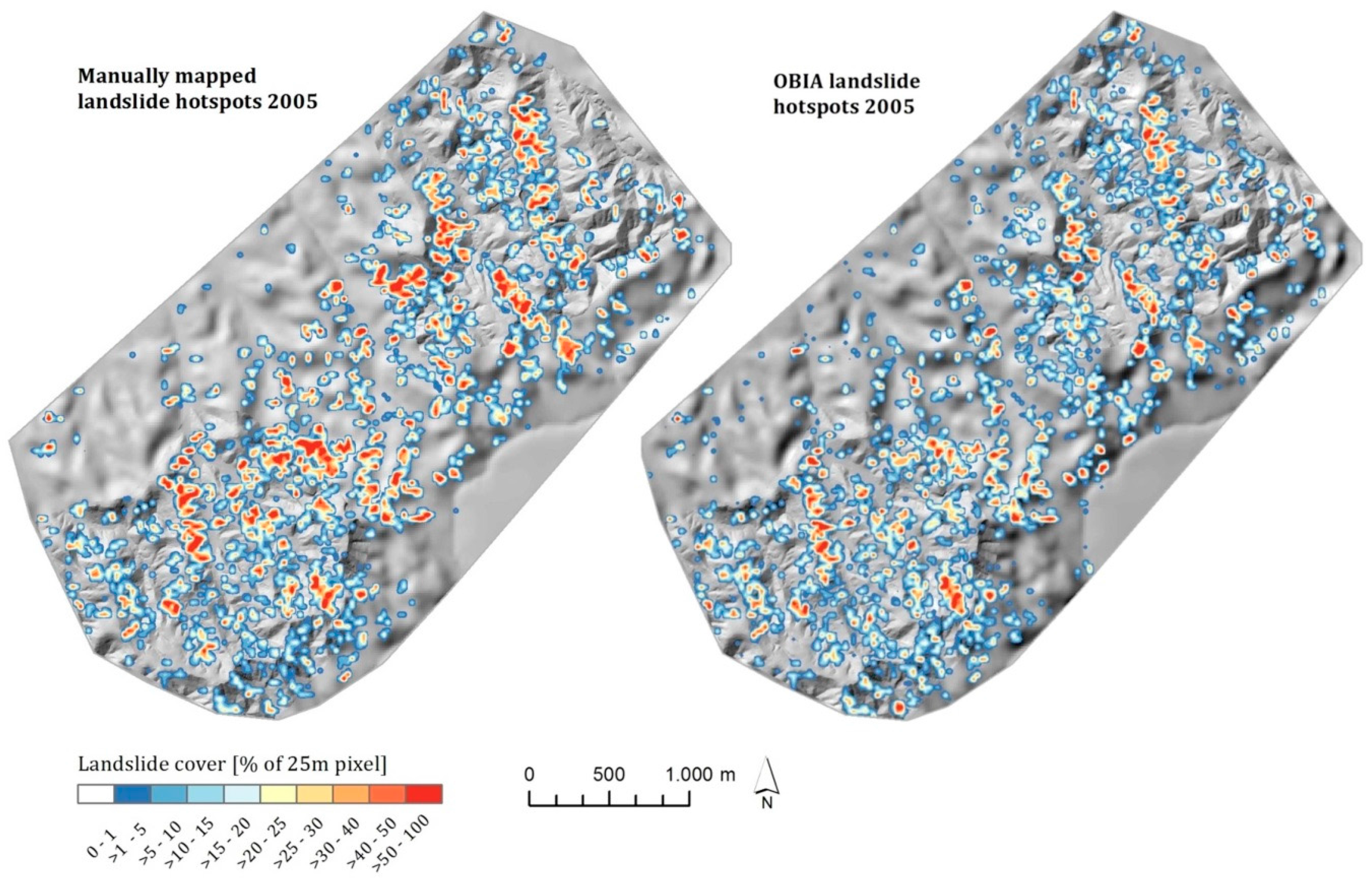
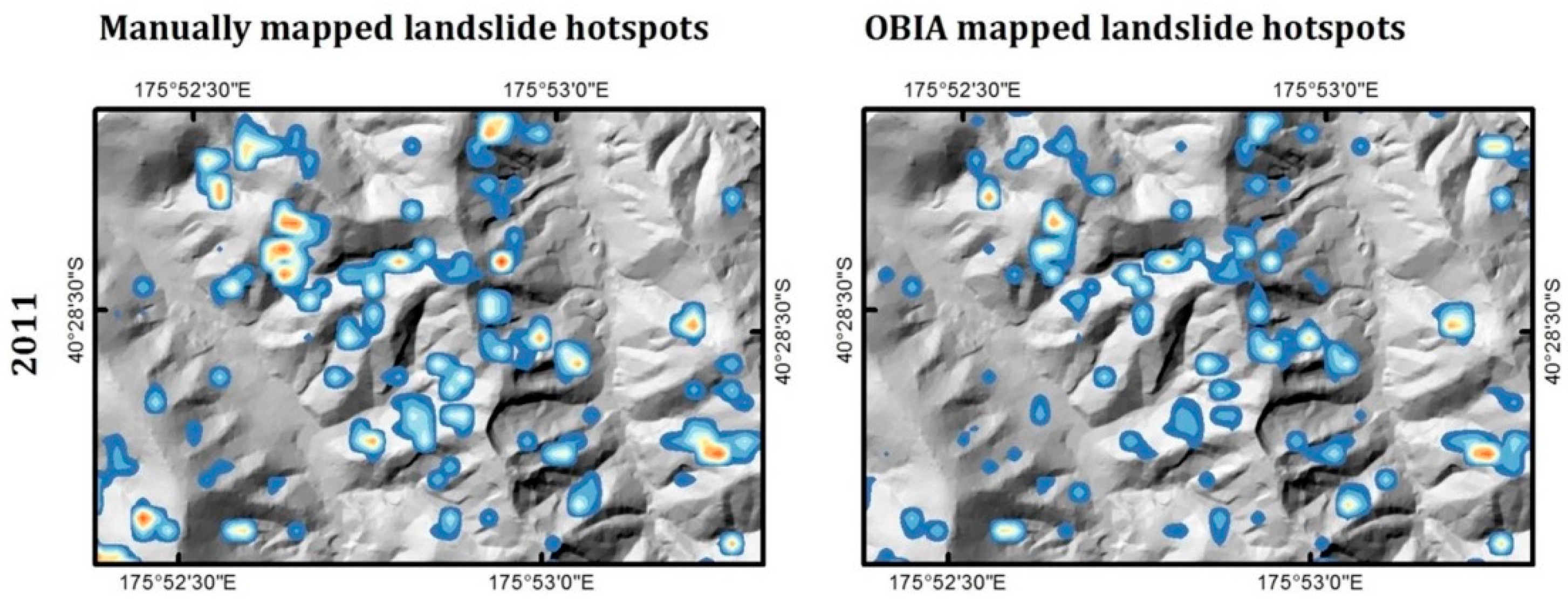
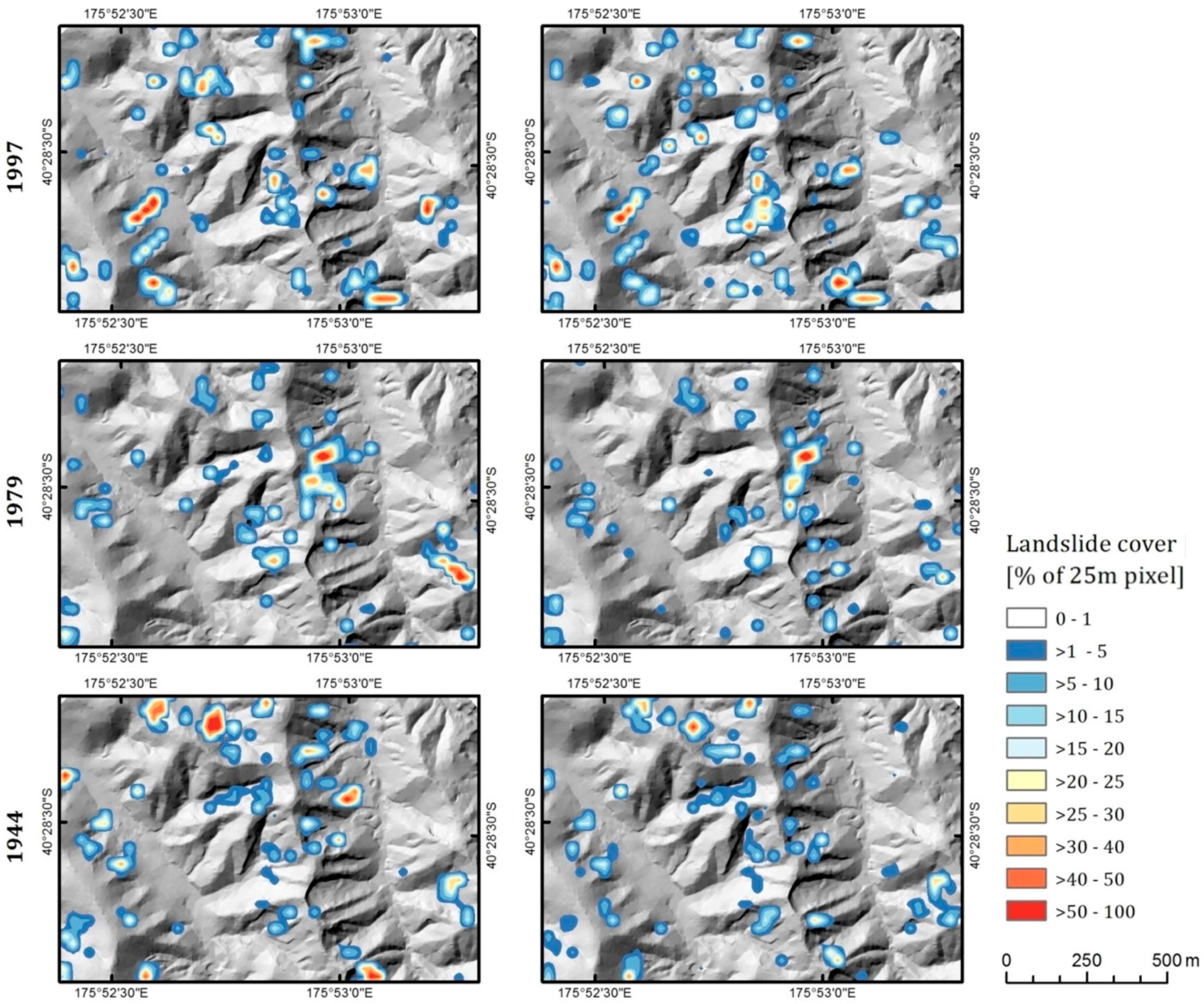
| Acquisition Date | Spatial Resolution (m/pixel) | Spectral Resolution |
|---|---|---|
| 25/01/2011 | 0.40 | three-band natural color |
| 16/01/2005 | 0.75 | three-band natural color |
| 01/05/1997 | 0.40 | panchromatic |
| 17/12/1979 | 0.40 | panchromatic |
| 31/03/1944 | 0.40 | panchromatic |
| Aerial Photograph | OBIA Mapping (ha) | Manual Mapping (MM) (ha) | Difference OBIA—MM (%) | Overlap Area (ha) | Producer’s Accuracy (%) | User’s Accuracy (%) |
|---|---|---|---|---|---|---|
| 2011 | 9.52 | 12.71 | −25.10 | 6.57 | 51.65 | 68.96 |
| 2005 | 44.66 | 56.63 | −21.15 | 34.59 | 61.08 | 77.46 |
| 1997 | 10.49 | 8.34 | +25.75 | 4.66 | 55.85 | 44.41 |
| 1979 | 4.74 | 4.82 | −1.68 | 2.29 | 47.57 | 48.38 |
| 1944 | 7.18 | 9.28 | −22.68 | 4.35 | 46.86 | 60.60 |
| Date of Rainfall Event >100 mm/Day | Max Daily Rainfall (mm) | Next Available Photography (Date) | Lag between Storm and Photography (Years) |
|---|---|---|---|
| - | - | 25/01/2011 | - |
| 16/02/2004 | 105.8 | 16/01/2005 | 0.9 |
| 11/04/1991 | 105.4 | 01/05/1997 | 6.1 |
| 18/02/1991 | 102.3 | - | - |
| 01/01/1980 | 106.4 | - | - |
| 03/02/1967 | 115.3 | 17/12/1979 | 12.9 |
| 04/05/1941 | 170.9 | 31/03/1944 | 2.9 |
© 2016 by the authors; licensee MDPI, Basel, Switzerland. This article is an open access article distributed under the terms and conditions of the Creative Commons Attribution (CC-BY) license (http://creativecommons.org/licenses/by/4.0/).
Share and Cite
Hölbling, D.; Betts, H.; Spiekermann, R.; Phillips, C. Identifying Spatio-Temporal Landslide Hotspots on North Island, New Zealand, by Analyzing Historical and Recent Aerial Photography. Geosciences 2016, 6, 48. https://doi.org/10.3390/geosciences6040048
Hölbling D, Betts H, Spiekermann R, Phillips C. Identifying Spatio-Temporal Landslide Hotspots on North Island, New Zealand, by Analyzing Historical and Recent Aerial Photography. Geosciences. 2016; 6(4):48. https://doi.org/10.3390/geosciences6040048
Chicago/Turabian StyleHölbling, Daniel, Harley Betts, Raphael Spiekermann, and Chris Phillips. 2016. "Identifying Spatio-Temporal Landslide Hotspots on North Island, New Zealand, by Analyzing Historical and Recent Aerial Photography" Geosciences 6, no. 4: 48. https://doi.org/10.3390/geosciences6040048





